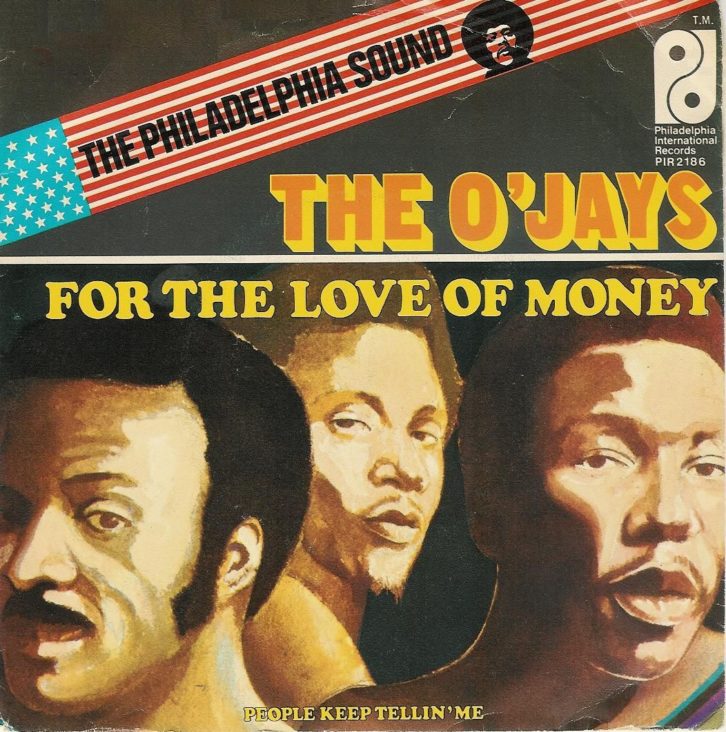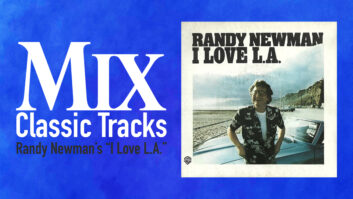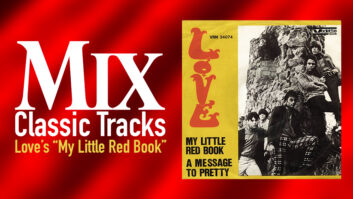 Though today Philadelphia is considered a secondary recording market, there was a time when the City of Brotherly Love was a major player in the music business. Philly’s first golden era came in the late ’50s, after Dick Clark’s phenomenally successful American Bandstand program, which began on the local WFIL-TV in 1952, went national on ABC in August 1957. Suddenly, Philadelphia was at the epicenter of the pop earthquake, and a web of music industry-related businesses sprang up in the city to cash in on the phenomenon. Teen sensations such as Danny & The Juniors, Fabian, Frankie Avalon, Bobby Rydell and Chubby Checker all came out of Philly in the late ’50s/early ’60s, as did DeeDee Sharp (“Mashed Potato Time”), The Orlons (“The Wah Watusi”) and The Dovells (“The Bristol Stomp”). Dick Clark had his own label, Swan Records, based in town, and then there was Cameo Parkway and Chancellor Records. Philadelphia even had its own equivalent to New York’s Brill Building-the Schubert Building at 250 South Broad Street “was filled with songwriters and managers and little one-stop record companies,” remembers Joe Tarsia, who was chief engineer at Cameo Parkway’s studio in those days. Kenny Gamble and Leon Huff, one of pop music’s greatest songwriting/production teams, got their starts, independently, in the Schubert Building.
Though today Philadelphia is considered a secondary recording market, there was a time when the City of Brotherly Love was a major player in the music business. Philly’s first golden era came in the late ’50s, after Dick Clark’s phenomenally successful American Bandstand program, which began on the local WFIL-TV in 1952, went national on ABC in August 1957. Suddenly, Philadelphia was at the epicenter of the pop earthquake, and a web of music industry-related businesses sprang up in the city to cash in on the phenomenon. Teen sensations such as Danny & The Juniors, Fabian, Frankie Avalon, Bobby Rydell and Chubby Checker all came out of Philly in the late ’50s/early ’60s, as did DeeDee Sharp (“Mashed Potato Time”), The Orlons (“The Wah Watusi”) and The Dovells (“The Bristol Stomp”). Dick Clark had his own label, Swan Records, based in town, and then there was Cameo Parkway and Chancellor Records. Philadelphia even had its own equivalent to New York’s Brill Building-the Schubert Building at 250 South Broad Street “was filled with songwriters and managers and little one-stop record companies,” remembers Joe Tarsia, who was chief engineer at Cameo Parkway’s studio in those days. Kenny Gamble and Leon Huff, one of pop music’s greatest songwriting/production teams, got their starts, independently, in the Schubert Building.
Around the time of the British Invasion, however, the scene in Philly began to change. Dick Clark moved Bandstand to Los Angeles, and the ascent of The Beatles, and rock bands in general, signaled an end of the teen idol period in American pop. “The business really changed,” Tarsia says. “What remained, though, was a core of music from the streets [i.e., soul music]. In the mid-’60s we were doing records with The Intruders-‘Cowboys to Girls,’ ‘Together.’ Kenny and Leon recorded ‘Expressway to Your Heart’ with the Soul Survivors. Thom Bell [a talented producer/arranger] was developing an act with The Delfonics-they did ‘La-La Means I Love You.’ They started to explode. Most of the work Kenny, Leon and Tommy were doing was not for their own labels but for others-Dusty Springfield for Atlantic, Joe Simon for Spring, Wilson Pickett for Atlantic, Jerry Butler for Mercury.
“By 1967 Cameo was fading into the sunset with all the other independents,” Tarsia continues, “so I decided to take a shot at running my own studio. I opened Sigma Sound in 1968, and right away we got a lot of work from Gamble and Huff and Thom Bell.” Sigma started as an 8-track studio, with Scully 4- and 8-track recorders mounted in one cabinet and wired with a supplemental harness to accommodate 12-track 1-inch, “a format that was not to be,” Tarsia says. The console was a custom 14-input Electrodyne model built from components.
Spurred by the success of Gamble and Huff, and Bell, Philadelphia once again became a major recording center from the late ’60s through the ’70s. Most agree that Motown was never the same after the label moved to Los Angeles in the early ’70s; indeed, it’s around that time that the Philadelphia Sound really began to take off and Gamble and Huff’s Philadelphia International label topped the pop and R&B charts with one song after another. Most of the Gamble and Huff productions recorded in Philadelphia used a stable of talented musicians that included bassist Ronnie Baker, drummer Earl Young and guitarist Norman Harris as a core group, augmented by such fine players as guitarists Bobby Eli, Roland Chambers and Bunny Sigler, organist Leonard Pakula, percussionist Larry Washington and vibist Vince Montana. Thom Bell’s sweeping string arrangements and Bobby Martin’s crisp horn charts brought a grandeur to the productions that hearkened back to the Big Band era but also sounded modern.
The O’Jays were not a Philadelphia band; the group was formed in Canton, Ohio, in the late ’50s. Originally a doo-wop quintet called The Mascots, the group became The O’Jays in 1961-the new moniker was a thank-you gesture to a Cleveland disc jockey named Eddie O’Jay, who had given them valuable support and career advice. They scored a few minor R&B hits in the mid-’60s, but by 1967 they were contemplating breaking up. The following year, though, they signed to Gamble and Huff’s Neptune label and their fortunes began to rise. By 1971, when Neptune folded, the group was down to a trio-Eddie Levert, Walter Williams and William Powell-but their best days were still ahead of them. Gamble and Huff regrouped and started the Columbia-distributed Philadelphia International label, and they wrote some of their strongest material for The O’Jays during this period. In 1972, the O’Jays had two chart-topping smashes-“Back Stabbers” and “Love Train.” Both were recorded by Tarsia at Sigma using the players mentioned above (except Ronnie Baker).
“For the Love of Money” was another socially conscious Gamble and Huff tune tailor-made for the O’Jays’ powerfully gritty vocal style. It was recorded in the fall of 1973 at Sigma. Typically, Gamble and Huff’s productions were done in three or four separate sessions, days or weeks apart. At the first session, Tarsia would record the basics on what was often a ten- or 11-piece group: “It was a mass of people to do rhythm,” Tarsia says. “On a typical Gamble and Huff record, if you count doubling, we would have 54 to 60 people-that’s almost a symphony orchestra.
“We might cut four tracks in a day; or we might cut just one and then recut it the next day if we didn’t like it,” he continues. “So rhythm was one day. Kenny and Huff would take the finished roughs of the tracks and listen to them over and over again and then work out the backgrounds and vocal parts. Then the next thing to be recorded was voices, when enough songs were assembled. With the O’Jays, they’d usually be around only for that; they’d do their parts and leave. If there was any kind of sweetening-like putting on another guitar part or a solo part-that would be done next. Strings and horns were a day, and then the mix was a day.”
By 1973, Tarsia had put in a 32-input Electrodyne console, and he was recording to 16-track Scully (the studio went 24-track the following year). “It was a primitive board,” he says. “It had one echo send and a three-setting equalizer. But we used to use outboard EQ-we had some API equalizers in the rack and a couple of Orban parametrics.” The studio had a 40x6x12 live chamber, as well as EMT reverbs.
Effects were usually kept to a minimum, but “For the Love of Money” is notable in part because it did have some interesting audio trickery on it. The relentlessly funky bass line by jazzer Anthony Jackson (who even received a co-writer’s credit for his contribution) is curiously altered, and then there’s the distinctive background vocal wash-the famous, ghostly refrain of “Money, money, money” blowing through the song like an ill wind. The song proffers the notion that money is the root of all evil, and sonically the effects on the track do sound sinister.
Tarsia credits another Philadelphian, Todd Rundgren, for getting him into experimenting more with effects. “Back when Todd was doing The Nazz, he came in here with an engineer from the West Coast and they had all sorts of interesting ideas. I was basically a one-man studio so I spent a lot of time on this. They proceeded to do things like take a guitar amp, plug it into a Leslie cabinet from a Hammond organ and turn the input up with nothing plugged in, so it made noise. They double-miked the rotating horn in the tone cabinet to produce a stereo swishing sound. Then they were flanging part of another song. They were creating all these psychedelic effects and it was totally fascinating to me.
“And I absorb like a sponge, so lo and behold a jazz player [Anthony Jackson] comes to Philly and he’s working with Gamble and Huff and he has a wah-wah pedal on his bass. Now the way Kenny used to work is he’d hand out chord charts to the musicians and Huff would sit at the piano and they would literally run down the song 20 or 30 times, and the musicians would start to gel together. Norman Harris would play a little guitar line, or Vince Montana would do something on the vibes, and they would weed and cultivate the arrangement. And after a couple of hours, they’d be ready to cut a track. On ‘For the Love of Money,’ I remember Kenny was sitting down on a stool in the middle of the studio, Huff was at the piano, and they were running down the song. I had just gotten an Eventide automatic phaser, and I heard that bass line and I plugged the phaser into [that and] the drum tracks and I thought, ‘I better play this safe because Kenny might not like it.’ I recorded them twice-once as I normally would and once phased. And when Kenny came into the control room he loved it. The other new toys I had just gotten were Kepex noise gates. We used that on the vibes-Kenny didn’t like the vibes on the record and wanted to dump them. I decided to try to get something out of the the vibes by employing a Kepex gate, which was triggered by the snare drum and gated the vibes, adding tone to the snare.”
As for the effect on the voices, after the O’Jays had left the background vocal session, “I took the tape, put it on the machine backwards and recorded echo on different tracks in reverse so the echo precedes the vocal. It’s reverse echo,” Tarsia says. “I was printing effects, but to the extent that I was covering my ass and had it with and without effects. The vocals were already down, so the backward echo was on another track and I would add that at will. And in the case of the drums, I doubled up. The other effects-the Kepex stuff, the echo on the bass-happened in the mixing. When we mixed it we went for broke. [On the opening of the track] Kenny reached up, grabbed the echo pot and turned it on the bass and then turned it off. At the time I hated it, but today I love it.”
On the album version of the song, which runs seven minutes and 21 seconds, the horn arrangement is fleshed out considerably and there’s some nice interplay between the lead trumpet and the rhythm section. Tarsia says the horn parts were worked out in a sweetening session by Gamble, trumpeter Rocco Benie and saxophonist Michael Pedicine Jr. Obviously, the single version is more compact, though no less effective. “For the Love of Money” made it to the Top 10 in the spring of 1974 (Number 9 pop, Number 3 R&B) and catapulted the group’s Ship Ahoy album to Gold status. The group continued to churn out Gamble and Huff-produced hits for the next few years-“Give the People What They Want,” “Let Me Make Love to You,” “I Love Music,” “Livin’ for the Weekend,” etc.-but they were briefly derailed by the death of William Powell in May 1977. He was replaced by Sammy Strain (of Little Anthony & The Imperials), and the group’s best-selling album actually came in 1978 with So Full of Love. Though they have long since split from Gamble and Huff, The O’Jays, still led by the incomparable Eddie Levert, continue to tour and record, inviting young and old to board the Love Train with them one more time.







